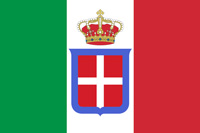World War I (1914-1918)

Eleventh Battle of the Isonzo
The Eleventh Battle of the Isonzo was a World War I battle fought by the Italian and Austro-Hungarian Armies on the Italian Front between 18 August and 12 September 1917.
Battle
The attack was carried forth from a front from Tolmin (in the upper Isonzo valley) to the Adriatic Sea. The Italians The Kingdom of Italy was a state that existed from 1861, when Victor Emmanuel II of Sardinia was proclaimed King of Italy, until 1946. The state resulted from a decades-long process, the Risorgimento, of consolidating the different states of the Italian Peninsula into a single state. That process was influenced by the Savoy-led Kingdom of Sardinia, which can be considered Italy's legal predecessor state. crossed the river at several points on temporary bridges, but the main effort was exerted on the Banjšice Plateau, whose capture was to further the offensive and break the Austro-Hungarian
The Kingdom of Italy was a state that existed from 1861, when Victor Emmanuel II of Sardinia was proclaimed King of Italy, until 1946. The state resulted from a decades-long process, the Risorgimento, of consolidating the different states of the Italian Peninsula into a single state. That process was influenced by the Savoy-led Kingdom of Sardinia, which can be considered Italy's legal predecessor state. crossed the river at several points on temporary bridges, but the main effort was exerted on the Banjšice Plateau, whose capture was to further the offensive and break the Austro-Hungarian Austria-Hungary, often referred to as the Austro-Hungarian Empire, the Dual Monarchy, or Austria, was a constitutional monarchy and great power in Central Europe between 1867 and 1918. Austria-Hungary was one of the Central Powers in World War I, which began with an Austro-Hungarian war declaration on the Kingdom of Serbia on 28 July 1914. lines in two segments, isolating the strongholds of Mount Saint Gabriel and Mount Hermada.
Austria-Hungary, often referred to as the Austro-Hungarian Empire, the Dual Monarchy, or Austria, was a constitutional monarchy and great power in Central Europe between 1867 and 1918. Austria-Hungary was one of the Central Powers in World War I, which began with an Austro-Hungarian war declaration on the Kingdom of Serbia on 28 July 1914. lines in two segments, isolating the strongholds of Mount Saint Gabriel and Mount Hermada.
After fierce and deadly fightings, the Italian Second Army, led by General Capello, pushed back Boroević's Isonzo Armee, conquering the Bainsizza and Mount Santo. Other positions were taken by the Duke of Aosta's Third Army.
However, Mount Saint Gabriel and Mount Hermada turned out to be impregnable, and the offensive wore out.
After the battle, the Austro-Hungarians were exhausted, and could not have withstood another attack. Fortunately for them (and unfortunately for their opponents), so were the Italians, who could not find the resources necessary for another assault, even though it might have been the decisive one. So the final result of the battle was an inconclusive bloodbath. Moreover, the end of the battle left the Italian Second Army (until then the most successful of the Italian Armies) split in two parts across the Soča (Isonzo), a weak point that proved to be decisive in the subsequent Twelfth Battle of the Isonzo.
To commemorate the participation of the Royal Bavarian Infantry Lifeguards Regiment, Georg Fürst wrote the March "Isonzo-Marsch".
HISTORY

RESOURCES
This article uses material from the Wikipedia articles "World War", "World War I", and "Eleventh Battle of the Isonzo", which is released under the Creative Commons Attribution-Share-Alike License 3.0.
© Stories Preschool. All Rights Reserved.










